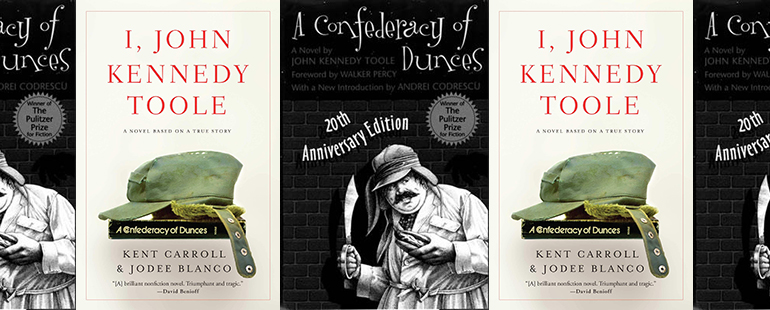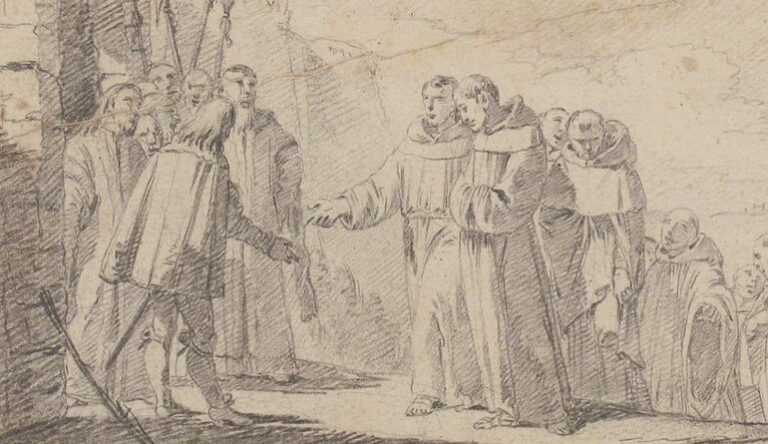The Canonization of John Kennedy Toole

Regarding Ignatius Reilly, the tragicomic antihero protagonist of John Kennedy Toole’s A Confederacy of Dunces, the Pulitzer-winning exploration into the various dubious characters that populated the complicated heart of 1960s French Quarter New Orleans, nearly every angle has been taken. Writers have dealt, in academic journals and on the web, with Ignatius Reilly and failure, with his timeless comedy, and with Ignatius as medieval crusader, to name a few. Of all the recent pieces, though, there is none more significant than Maurice Carlos Ruffin’s 2016 reexamination of Ignatius Reilly for 64 Parishes. Ruffin addresses the most salient themes of Dunces head-on—labor, misogyny, and racism. His is the perspective of a New Orleanian and a Dunces fan, and it is also a response to critiques of the book, which include that depictions of Burma Jones, a “vagrant turned janitor,” and Ignatius’ attitude towards Dorian Greene, a queer French Quarter personality, are stereotypical, even discriminatory. “The book’s attitude toward its LGBT characters is similarly ambivalent,” Ruffin writes. “Ignatius refers to Dorian Greene and his party-going friends as perverts, degenerates, deviates or sodomites.” Ruffin decries interpretations of these characters as stereotypical, citing W. E. B. Du Bois’ idea of “double consciousness” as their underlying strength. Burma Jones “may be an offensive stereotype, but he’s an offensive stereotype in a satire where virtually none of the other characters have any meaningful level of self- or social-awareness.” Ruffin’s interpretation is that Ignatius’ depth isn’t that he’s a polymath, but in how the grease shine of his bulbous features serves as a mirror, reflecting the strength of the marginalized.
After reading Ruffin’s piece, I felt like nothing more really needed to be said about the book. But still, I wanted to find a way into the conversation about Ignatius. Why? The inexorable ghost of Ignatius Reilly has haunted me since I first read Dunces as an undergrad. I accidentally stumbled onto the bronze statue of Ignatius on Canal Street one Bourbon Street evening. One of the first Instagram accounts suggested to me by the app’s algorithm was @workingboyignatius. On a flight last year, I sat next to an elderly Ecuadorian woman whose only carryon item was a tattered first edition of Dunces in Spanish. She told me that she never traveled without her “Saint Ignatius.” The book’s language became our inside joke for the rest of the flight. We even gave Ignatius a Spanish pet name: Nacho. When I had to wake her so that I could step over her to get to the restroom, I blamed it on my “valve” acting up. Mi válvula, I said. There’s nothing to calm the nerves that come with air travel today like an inside joke about Ignatius’ gastrointestinal issues between Dunces fanatics. The character’s quirks even snuck into my own manuscript-in-progress. Only extensive drafting could remove from my protagonist his Ignatius-like tendencies to judge those around him with unearned scrutiny. A character like this could only successfully be drawn by the hand of a master, and in that pursuit, I might find my own demise. Ignatius’ creator, after all, took his own life when he couldn’t find the right venue for the character in the world. Through this obsession, I found myself wondering what drove John Kennedy Toole to persist in this creation.
Enter the novel I, John Kennedy Toole, by Kent Carroll and Jodee Blanco, a fictionalized biography of the eponymous author’s life. Published in May, forty years after Dunces, the book reads the same way as a biopic of a rock star watches: Toole’s personal relationships are romanticized and amplified. So are the moments he stumbles upon inspiration for a fictional character we might recognize. In one such scene, Carroll and Blanco write the author into a table at the Gaslight in the late 1950s, playfully flirting with a musician named “Joanie.” Though there’s no character double for Joanie in the original text, readers of Dunces would recognize the beat-troubadour character as one element of Ignatius’ romantic interest and pen pal, Myrna Minkoff. Joanie explains to him the reason people snap instead of clap at the Gaslight (the upstairs neighbors complain about sound coming through the pipes), then the two step outside. “Joanie sang a song for Kenny right there standing on the sidewalk,” Carroll and Blanco write, “a lovely ballad about a girl named Flora who betrayed her lover and how it drove him to do something awful. It made Kenny think of David from The Neon Bible and how he had to do something awful, too.” The authors imagine how Toole may have found inspiration in New York for his first book, The Neon Bible, which was unpublished until after the success of Dunces. In that book, the teenage protagonist is suffering from depression and abject poverty, and decides the only way he can exert control is to commit a mortal sin.
To take a figure like John Kennedy Toole and place him as a young genius in the company of rock stars—in Greenwich Village at the peak of the Beat Movement, no less—is to steep the story in cinema. Blanco and Carroll suffer from the same obsession that cult followers of Dunces do. We long to see those associated with the creation of this book in the flesh. At the outset of each chapter, the authors ground the scene in context. “It’s 1969, the year Richard Nixon is inaugurated,” they write, “and on Christopher Street in New York’s West Village, one Saturday evening in June, at a bar called the Stonewall Inn, a riot breaks out. It lasts all night.” This device may seem trivializing, especially because in the next paragraph we see Toole running a hose from his exhaust pipe into his car, but it places him clearly in a time and place. I’m able to picture Toole. He’s like a cinematic Frankenstein: part tragic romantic like Val Kilmer as Jim Morrison in The Doors, part witness of historical moments like Tom Hanks’ Forest Gump, and part traveling jester like Cate Blanchett as Bob Dylan in I’m Not There.
There are multiple nods to film throughout I, John Kennedy Toole, and rightfully so. Readers of Dunces might recall that Ignatius is a discerning critic of the latest motion pictures, stuffing his face with popcorn and guffawing at attempts he deems crude. In one comic scene in I, John Kennedy Toole, Ken and his pals think they’re going to see an Ingmar Bergman picture, but instead they accidentally end up watching Godzilla. Running concurrent to the threads of Ken trying to get Dunces published with Simon & Schuster editor Robert Gottlieb and the sad story of his upbringing, including his famously overbearing mother Thelma and sickly father, runs the story of Bill Greeley, a New York Post reporter who arrives on the shores of Nantucket forty years after Toole’s death for a film festival with no story, only to find that he’s staying in a room that the author once occupied in an attempt to find peace from the bustle of the city for a weekend. By coincidence, he sees on the festival calendar that a Steven Soderbergh-assembled table read of the book is set to take place. His fascination with the story sends him on a search that could be metaphorical for any fanatic’s obsession with the book.
Greeley’s narrative also serves as an entrée into the many failed attempts to adapt Dunces into a motion picture. Rumors abound that attempts have been cursed, with John Belushi and Chris Farley both dying untimely deaths when conversation turned to them playing the role of Ignatius. Greeley attends the table read, and afterwards observes that, despite the crew being aglow, something is missing. “What struck Greeley most was everyone’s reverence for Toole,” Blanco and Carroll write, “There was an unspoken sadness that the author wasn’t there to share in the excitement.” The proprietor of the inn Greeley’s staying at recalls to him her encounter with the young Toole when he’d come there all those years ago. How she could see “in his eyes a thousand untold stories.” She shares with him how the charming young man told her that “all he wanted to be was a writer.” These fictionalized accounts by Carroll and Blanco help give fans some closure regarding the life of John Kennedy Toole where there’s really been none.
Toole’s mother pushed him incessantly towards creative success. He helped care for his sickly father as he experienced dementia on the slow road to his death. And he began to display signs of schizophrenia around the time his novel was rejected for publication by Simon & Schuster. We’ve spent so much time discussing Ignatius: his multi-dimensional, timeless creation, but have ignored saying the obvious about John Kennedy Toole—that much of the Dunces mythos is built on the back of his suicide. “Did all the drama and mystery behind this book contribute more to its success than was politic to admit?” Caroll and Blanco write, “Tragedy has legs, thought Greeley.”


